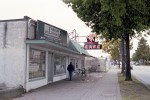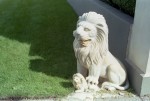Nov
25
2018

As this was my first go with the Konica Auto S3 I used some outdated Fuji 400 film just to make sure it worked and boy did it ever. Despite the film handicap I placed on the camera it gave some excellent results. The lens is 38mm f1.8 with 6 elements in 4 groups but its the smooth nature of the out of focus areas that I think make it great. This image being the best example of the look it produces at wide apertures.

As for flash photography the Auto S3 has a unique feature. Without a flash the camera operates as a shutter priority exposure system with a needle in the viewfinder indicating the aperture that will go with that shutter speed. However when you place a flash on the hot shoe there is a little lever that then switches the camera over to automatically select the aperture based on the focus distance. Of course this is intended to be used with a dedicated flash that had a fixed guide number. Fortunately the guide number can be set with the little button at the base of the lens from 22-180. So if you are using a fancy flash that can adjust its output set it to manual and then set the guide number for that flash on the S3. With a flash on the camera a green indicator (synchro mark) becomes visible in the viewfinder and points at the aperture that will be used. If you then adjust the shutter speed so that the aperture needle matches the synchro mark you will have balanced the metered light and the flash. With the Auto S3’s leaf shutter you can sync all the way to the maximum shutter speed of 1/500 second. This should allow for some interesting daylight flash techniques.
no comments | posted in Cameras, Photography
Nov
18
2018

Originally I had a Yashica Zoomate 140 SE but that was stolen out of my vehicle with a number of other nearly worthless cameras, jokes on you loser. What the SE offered over this plane 140 I’m not sure maybe ‘Summer Edition’ or ‘Sucks Emulsion’ I can’t actually complain too much about this camera because it produces decent images though a little soft and with some coma distortion in the corners as well as some pin cushion to boot. That does sound like complaining doesn’t it? You have to compare it against its rivals though and in that case as a compact telephoto point and shoot its decent. You can find some more details about the camera in the link I posted above and some images from this roll down bellow.
no comments | posted in Cameras, Photography
Nov
10
2018

The Minolta V2 doesn’t have a light meter and that’s probably just as well because a 60 year old meter isn’t likely to be that accurate if it works at all. Setting the aperture and shutter for a certain light level then is up to you. There are a couple restrictions when you go over 1/500 of a second. At 1/1000 second the maximum aperture you can use is f4 and at 1/2000 it is f8 but if there is enough light for the film your using no other camera from the time comes close to as fast a shutter speed.

Of course they fail to offer any ideas as to how you are going to get close enough to a ‘jet air plane’ to take a picture of it in flight with a 45mm lens. (P.S. that’s a Lockheed 104 which was a supersonic jet from around 1958)
In addition to having a high shutter speed available the lens on the Minolta V2 is excellent not just for the time but even today. The maximum aperture of f2 is decently fast and the lens has very good correction of aberrations. In particular chromatic aberrations such as colour fringing around high contrast areas. Combing through the various rolls of film I have shot with this camera I cant really find an example of it.

no comments | posted in Cameras, Photography






































































